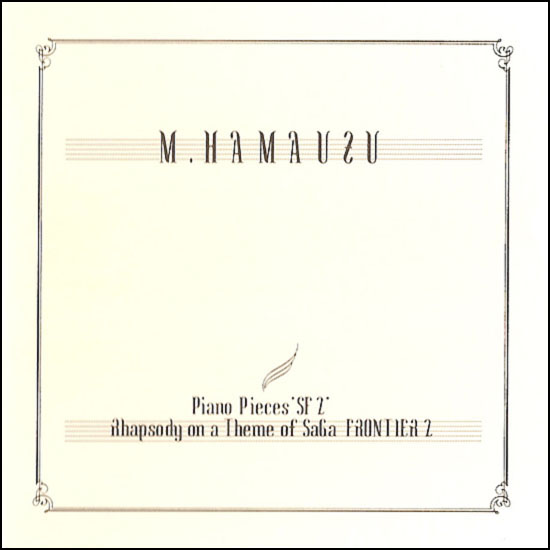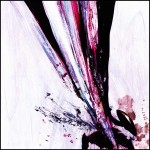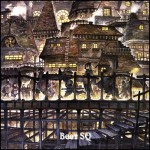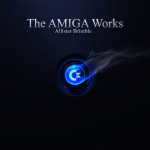Before delving into this review, if you don’t know anything about the impressionist music movement of the late 19th and early 20th centuries, I’d recommend doing some research first. Not understanding impressionism, and not knowing the names and works of Debussy and Ravel (the most well-known impressionist composers, both French), you will likely not grasp the full review.
The reason we’re talking about this decade-old album? It took some time, but Square Enix finally did a reprint of “Piano Pieces SF2 ~ Rhapsody on a Theme of SaGa Frontier 2.” This is an arranged album for SaGa Frontier 2 that features 18 piano tracks (some solo, some duet), followed by 6 tracks of chamber/ensemble music working under one title (the second half of the album title). With the reprint finally released (and with a bonus track in tow!), we thought this was as good a time as any to talk about it.
After the jump, our full review of this excellent arranged album from Masashi Hamauzu.
I’m not providing a tracklist to this album. Why? It’s a bunch of Greek characters and numbers. The tracks are named by performers, most of whom were university students that Hamauzu worked with in the creation of this album.
Now, each of the 18 tracks of the piano section have a corresponding track from the SaGa Frontier 2 Original Soundtrack, even with the many variations of the same theme found from track to track on the OST. You can tell the difference via the rhythm or harmonic structure, even with the melody is virtually the same (you know: G, F G D Eb Bb C).
So let’s just get right into it.
Impressionist music is known to evoke images and settings better than pure emotion. That said, it isn’t as though impressionist music is dry, or lacking in emotional power. Indeed, the power to present an image in the listener’s mind through music is something intensely moving; perhaps I could even describe it as “Spiritual.” Listen to some piano solo or piano-led chamber music by Debussy and you’re almost sure to catch my drift.
Though Hamauzu isn’t Debussy or Ravel, he did bring a strong sense of revival to the musical tradition with the SaGa Frontier 2 score. Combined with the game’s watercolor visuals, it was a powerhouse of beautiful settings that one can frame in one’s mind: sometimes light and airy, other times dark and brooding. And while the soundtrack in its original, synthesized form was fantastic, the piano arrangements really took the sound and put it in a place that fans of classical impressionist music could really sink their teeth into. I am one of those fans. It’s like this album was designed for me.
Listening to this album makes me feel smarter. Seriously, with each subsequent listen, I feel like my mind has been enriched. Consider the opening track. In the first three measures, the chord progression (based on the left hand) is A major (C# in bass), Bb major, then A minor. Wait, what? That sounds completely unnatural. It sounds terrible, conceptually. But listen to this flowing 6/8 piece yourself and you’ll quickly acknowledge that it’s actually perfect. It’s a stroke of genius. As the piece builds, the vacillation between Bb and A eventually works its way to an F major (A in bass) and then the resolved D-suspend (the resolution has no clarification of major or minor?!) with flat 7 (in the bass: D, A, G, C). I love it. There’s then a short bridge with all sorts of strange chordal stuff, though it seems to again rely on the Bb/A balance.
But! Throw out all the technical harmonic stuff and what you get is a simple, airy sort of piece. It makes me want to spin in circles in a grassy field. Actually, most of the album makes me feel that way.
The very next track paints a wholly different picture. You know what the ticking of a clock sounds like, and you know what a clock’s chimes sound like. What if each tick was a chime? That’s the impression I get from the second track. Though each repetition of the high and low chords adds an increasing layer of melodic complexity, the key is that up-and-down chiming. One can also imagine bobbing on the water in a small boat, but for me, the clock is the key image. Nonetheless, again, what an absolutely beautiful, simple piece of piano music.
The third track makes me think of shopping in a provincial European town. No surprise that this is one of the ways in which the source music was used in SaGa Frontier 2. This piece has a faster tempo than the previous two, yet it feels ever lighter, mainly because there’s so much happening in the upper octaves. The lightly-played sixth and seventh harmonies in the left hand are all we get that even gets close to reaching the bass octaves.
When I was young … like, 11 years ago when I first heard this album, the first piece I wanted to learn how to play was track 4. And learn it I did. Like the first track’s seemingly simple change from A major to A minor, this piece plays between F major and F minor. The major portion uses sevenths to keep things ambiguous (G is the lowest bass note in the opening measure? seriously?!), but the second portion with F minor (and Bb minor) is unassuming in its bombast. It’s such a sharp change, and I love it. And it’s one of the shortest tracks on the album, too. Granted, most pieces on this album barely surpass the 2 minute mark: these are more like Bartok’s Mikrokosmos than Debussy’s Preludes in terms of bulk and long vs short form. This in no way makes the music forgettable. If anything, you’ll be able to remember these pieces more easily because there are only a few themes upon which to pick up. The rest is, well, “impression.”
I know I’ve been track-by-tracking this review, and that’ll stop soon. I want to talk about track 5 in detail. “B1” (B being “beta” in Greek) begins the five-part section of the second pianist. The Square Enix reprint of the album, SQEX-10197, has as its bonus track a new recording of this piece. For the opening measures, they are basically the same piece, though the melodic turns on track 25 and the little decorations are different. You can also hear some clicks and clacks on the piano; this one wasn’t mixed to perfection. It seemed like a short, one-take recording that was thrown on the disc as an afterthought. In other words, if you already own the original print, the reprint probably isn’t worth having. But for those who never had the CD, it’s nice to have an extra 2 minutes of music with your reprint. But anyway, yes, this piece is a very memorable melodic piece. On track 5, the tempo is faster, and it is far more “traditional” in its tonality; almost Romantic instead of Impressionist. Very lovely indeed.
Okay, I’m still going in order. Track 6, “B2,” is another personal favorite. This is one that I never learned to perform in full, though I’d like to when I have more time to study it. In premise, the function is similar to track 2: hold the harmonic structure, build the melody and decoration with each repeat. But then, Hamauzu throws a wrench in it with some fancy chord changes. In my mind, I can imagine either a rural “camp” setting, or a medieval urban setting, sneaking behind low-lit buildings and alley ways. Can you imagine it? Listen along, I think you can.
Skipping ahead! “B5” is another favorite, and one of the earliest pieces I learned to play. It’s a fun romp in the land of major and minor sevenths, essentially. There’s a part you can even dance to in the B section. You can imagine hoof prints and the galloping of horses, and you sitting in the carriage in the back, and then finally arriving at your destination. The whole track repeats once, so it’s 1 minute 13 seconds repeated twice, coming to 2 minutes 26 seconds. I think you’ll want to put this one on repeat and enjoy it a few more times.
Tracks 10 through 14 are piano duet pieces, and if you find yourself a little underwhelmed by the sound of piano solo, let the robust nature of these tracks pick you up. For me, it’s the backup, decorative, subdued stuff that makes the song, not the melody. Though, of course, the melody is a necessity. A variation on SF2’s main theme, found on track 14, is a great example of piano duet done right. And it most definitely holds Hamauzu’s Impressionist style together. If you’re looking for other great duet tracks, well, just listen to all of these pieces. Track 14 will always be my favorite, but if you want something simple and dark, try track 13. That’s like a “tension in the rich dude’s manor” kind of theme song.
The last few piano tracks (15 through 18) are a little different from the rest of the lot. There is just something different about the whole style and timbre. Since each section of tracks is done by a different performer, that accounts for a lot of it. A personal favorite among these tracks is track 17, the longest track on the whole album (3 minutes, 26 seconds). The entire track is built up as a combination of whole- and half-note chords in the bass area, then random touches of “melody” in the right hand. Hints of Hamauzu’s future are found in this track: you can hear concepts hear that would later transition into Final Fantasy X and Unlimited:SaGa. It’s slow, it’s brooding, but it’s something that sticks with you. Gives me the heebie-jeebies, but in a good way!
After all that piano goodness, like a tasty multi-serving of soup salad and appetizer, we get the entree. Or, in other frames of reference, we get the climax. “Rhapsody on a Theme of SaGa Frontier 2” is the second part of the album. Tracks 19 through 24 are all considered one piece of music (the tracks are not labeled with individual titles, though there are clear distinctions in the music). This is, like much of the SaGa Frontier 2 OST, very much a “variation on a theme” kind of affair. And it will blow your mind.
What instruments are featured in the rhapsody portion? Piano, obviously. And strings, and woodwinds, and French Horn, and cymbals and bass drums. This ten minute suite is something I will cherish forever. No one who listens to it more than once will be able to pass it off as uninteresting or mediocre. Track 19 alone, using the same theme as on track 14, will blow your mind. The dynamic range and pulse-pounding tempo will keep you on the edge of your seat. And the way the track ends … wow! Y’know the ultra-repetitive build at the end of the Final Fantasy X piano version of “Raid?” It’s like that, but better. Way better.
Track 20 is like a minor, 3/4 version of track 2 from the piano version. It’s got the piano doing those bouncy 4ths and 5ths with the occasional melodic descent. The strings provide sustaining chords when the piano part isn’t up for the job. I love that this whole part is in a minor key. It’s so dark and enigmatic. Brilliance in a 90 second piece of music? You better believe it!
As the piece eventually comes to its end, we hear some very different sounds. Track 23 has big, bursting percussion and swells of woodwind and French horn. Oh, it’s perfect. But then, to close out, we get this vivace-tempo gallop away from the world. It’s bouncy and fun, more so than any other track on the album. This chamber music is excellent. Just simply excellent.
The album’s packaging is a simple plastic jewel case. But they pulled off a miracle with this case. The original print came with cardboard sleeves, and one sleeve held a tiny booklet that, when folded out, contained all the music to the piano section (tracks 1 through 18). Somehow, through some miracle, they are able to get this same booklet to fit in the front part of a single CD standard plastic jewel case. A book that thick, I would think, would require a double-wide case. I was wrong. And I’m happy the sheet music is there. Any mid-level piano performers can pick up on a few of the easier pieces; it’s a joy to learn to play, as it is a joy to listen to the album in full. It’s currently available from CD Japan and Play-Asia.
Your thoughts on this excellent album? Can Hamauzu ever top this? Has he already topped this, and you think I have an inflated view of this album? Leave your comments, and watch for tomorrow’s special post, where you’ll have an opportunity to win a copy of this album!
Tags: Arrangements, DigiCube, Masashi Hamauzu, Music Reviews, Piano, Piano Pieces SF2, reprints, Rhapsody on a Theme, SaGa Frontier 2, SaGa Frontier II, Square Enix









































…Is it okay that I was a little disappointed upon discovering the ‘SF2’ didn’t stand for ‘Street Fighter 2’? I hope so. Because I was.
I enjoyed reading this review, now I wish I had the technical know-how to appreciate all the crazy things going on in the soundtrack heh. I’ve always loved this OST, the Playstation had so many good RPG soundtracks it’s unbelievable.
And now that I’m listening to it, I feel like it’s also okay to say my disappointment was purely superficial — although I do have a piano version of Ryu’s theme from SF2 somewhere and think it’s pretty nifty.
“It’s like this album was designed for me.” Oh yes. This is very evident. I’m surprised you didn’t make this a SOTM. I think it more than deserves that. Especially with your technical expertise.
My ineptitude with music theory isn’t just an absence of ability, it’s a failure to grasp (10 years of piano did little but make me hate practice and get my fingers ready for very fast typing). So when I say I looooove this album, and listen to that very first track over and again, trying to pick out nuances and variations based on your very clear description, I think I’m adding the layman’s vote. On the other hand, I can see why a budding pianist would want to try some of these. They’re not all crazy-fast complex Hamauzu stuff such as you’ll find in FFX a la ‘Assault’ and ‘Decisive Battle.’
Listening to this doesn’t make me ‘feel smarter,’ but it does sort of make me realise that that is precisely how it’s meant to make me feel. Like some books (because that’s my ‘makes me feel smarter’ realm), written for certain audiences. Many of them flop because they fail to appeal on any level beyond that. Hamauzu’s work does not come even close to that failure, and its reprinting is truly worthy.
I like this a lot more than FFXIII’s OST in fact. You can’t do a whole game soundtrack with piano alone (not an FF at any rate) so I guess it’s an unfair comparison, but this album is so clearly Hamauzu doing what he does best with no expectations beyond that. Which, really, is the most any of us could wish for.
Bloody great review, Pat.
wow. That was a much-needed confidence booster. Go OSV staff supporting one another! Thanks Wes!
And, yeah, the insanity of the FFX stuff (or, even, something like Fang’s Theme from FFXIII) is a little much at times. SF2 Piano is beautifully and deceptively simple.